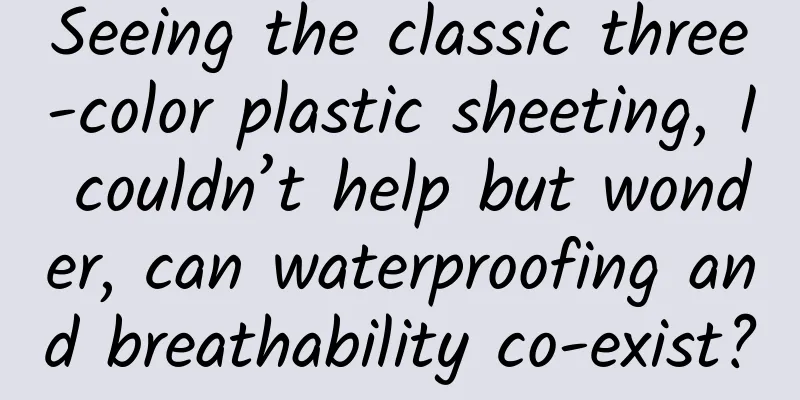Seeing the classic three-color plastic sheeting, I couldn’t help but wonder, can waterproofing and breathability co-exist?

|
Produced by: Science Popularization China Author: Shi Chang (PhD in Physical Chemistry) Producer: China Science Expo Recently, the classic three-color waterproof plastic sheet has attracted widespread attention on the Internet. Whether it is electronic products, outdoor clothing, or house construction, they are all closely related to waterproof materials. How do the waterproof materials in our lives protect us from rain and rain? Three color plastic cloth (Photo source: veer photo gallery) Various waterproof materials 1. Classic and versatile plastic sheeting Plastic sheeting can be described as an "all-rounder" in the field of waterproof materials. Due to its low price, ease of use and excellent waterproof performance, it frequently "appears" in many application scenarios. Plastic sheets are usually made of polymer materials, such as polyvinyl chloride (PVC), polyethylene (PE) or polypropylene (PP). These materials have long carbon-containing molecular chains or hydrophobic side chains (methyl or chlorine atoms), which show lower surface energy than water. Water molecules can easily slide away from the surface of the material, reducing the accumulation of rainwater. The hydrophobic effect of lotus leaves (Photo source: veer photo gallery) Surface energy can be understood as an interaction force between solids and liquids. If the surface energy of a material is low, the interaction force between solids and liquids is weak, and it is difficult for the liquid to stay and spread on the solid surface, thus exhibiting hydrophobicity. In addition, the internal molecular structure of polymer materials is relatively tight, and the gaps between molecules are very small, making it difficult for water molecules to penetrate the surface of the material. This is another important reason why plastic sheets are waterproof. 2. Asphalt, which smells bad, is indispensable for building waterproofing Asphalt is one of the common building waterproof materials. It is composed of hydrocarbons of different molecular weights and their non-metallic derivatives. It is dark brown and emits a foul smell. Asphalt has a tight molecular structure and is impermeable. Due to the presence of a large amount of hydrocarbons, it has strong hydrophobicity and is a material with good waterproofing effect. Asphalt is solid or semi-solid at room temperature and usually needs to be heated when used. When heated, the fluidity of asphalt increases, which can better fill small gaps and prevent water penetration. Roof waterproofing repair (Photo source: veer photo gallery) 3. Nano-coating, invisible "protective clothing" for electronic products The waterproofness of electronic products is mainly related to structural design and nano-coating. Structural design improves the airtightness of the mobile phone joints through waterproof strips and sealing rings. Nano-coating is to put on "protective clothing" for the surface and internal components of the device. Nano coating uses silane, nitrogen and other raw materials, and can deposit a dense hydrophobic nano coating (silicon-based material) on the surface of electronic devices and internal semiconductor components through the method of plasma enhanced chemical vapor deposition (PECVD). When water droplets touch the surface of electronic devices, the presence of the hydrophobic coating will cause the water droplets to slide off quickly. Even if water droplets enter the interior of the device, the coating on the surface of the components will prevent the water droplets from damaging the circuit. Cell phone immersed in water (Photo source: veer photo gallery) Waterproof and breathable, how to achieve both? The waterproof performance of waterproof materials is related to two factors: hydrophobicity and water droplet permeability. As outdoor clothing, it must not only have good waterproofness, but also good breathability. The pore structure is the main reason for the breathability of the material, but the pores will also allow water droplets to pass through, reducing the waterproof performance. What a contradiction! How can we achieve both waterproofness and breathability? GORE-TEX technology fabric, known as the "cloth of the century", successfully solves the contradiction between waterproof and breathable, and has become one of the most popular materials in outdoor sports equipment. Water drops on jacket (Photo source: veer photo gallery) GORE-TEX material is mainly composed of polytetrafluoroethylene (PTFE) film, which contains hundreds of millions of microporous structures. The size of these micropores is micrometer-level, which is thousands of times smaller than liquid water droplets, but water vapor molecules can easily pass through. When doing outdoor sports, water droplets will hardly penetrate the material due to its excellent hydrophobicity and small pores. The sweat inside will be discharged through the micropores in the form of water vapor, achieving the effect of "both" in terms of waterproofness and breathability. Triboelectric nanofabric: waterproof, power generation, and accelerated perspiration In August 2023, Chinese scientists published a study in the internationally renowned journal Advanced Materials on a nano-fabric with high-performance waterproof and high-perspiration properties using triboelectric nanostructures. This fabric can use frictional power generation to promote perspiration from the fabric. The research results were published in the journal Advanced Materials (Image source: Advanced Materials magazine) The researchers used the charged liquid jet technology to combine hydrophobic ferroelectric polyvinylidene fluoride-hexafluoropropylene (PVDF-HFP) and hydrophilic polyurethane (PU) to prepare a composite fabric. The pore size of the fabric is only 0.62 microns, and the porosity is as high as 78%, which effectively prevents water droplets from passing through and provides more water vapor channels to promote sweating. The PVDF-HFP nanofilm on the surface of the fabric has hydrophobic properties, and water droplets are not easy to stay on the surface. In addition, the PVDF-HFP nanofilm can also generate friction voltage under the action of mechanical stretching. Under the combined action of the electric field and the passive perspiration of the hydrophilic PU nanostructure, sweat is converted into smaller water molecules, which are easier to be discharged from the body through the microporous structure of the composite fabric. Schematic diagram of electrospinning technology; b. Schematic diagram of the waterproofness, breathability and perspiration of nanomesh fabrics; ce. Electron microscope images of fiber materials; pore size comparison of nanofibers and nanomesh fabrics (f), friction voltage comparison (g), waterproofness and breathability comparison (h); i. Demonstration of the waterproof and breathable capabilities of nanofabrics; j. Thermal and hygroscopic comfort of nanofabrics; k. Large-scale nanofabric images (Image source: Reference 1) The results show that the composite fabric exhibits high waterproofness (hydrostatic pressure, 129 kPa) and breathability (vapor permeability rate, 3736 g/m2/day). Compared with commercial polytetrafluoroethylene membrane, the composite fabric has lower evaporation resistance (13.1 Pa·m2·W-1) and thermal resistance (3.9 mK·m2·W-1), and has better hygrothermal comfort. Conclusion From traditional asphalt and rubber materials to modern nanocomposites, the innovation of waterproof materials continues to expand the boundaries of science and technology. With the advancement of science and technology, we look forward to more efficient and environmentally friendly waterproof materials emerging in the future, bringing greater improvement to our quality of life. References: 1.Gong 2.Tang ZQ, Tian T, Molino PJ, et al.Recent Advances in Superhydrophobic Materials Development for Maritime Applications[J]. Advanced Science, 2024. 3. Jiang Yuansheng. Research and application development of new flexible tent materials[J]. Industrial Textiles, 1996. 4. Yu Wei, Liu Lihui, Hou Haihong, et al. Helicon wave plasma enhanced chemical vapor deposition of silicon nitride thin films[J]. Acta Physica Sinica, 2003. 5. Chen Fumin. Windproof, rainproof and breathable jacket[J]. Chemical Engineering Management, 2013. |
<<: Do you have the habit of "washing your butt"? Don't be shy, it's a good habit...
>>: Frankenstein is not fiction? There are also "stitched monsters" in the ocean~
Recommend
Douyin operation: How to create a popular Douyin account?
Is TikTok still in its bonus period? Douyin has e...
5 Best AngularJS Program Building Frameworks
[[151096]] If you are planning to use AngularJS t...
Factorial delivers solid-state battery B samples to BMW and Mercedes-Benz. Is the United States overtaking China?
Recently, Factorial, an American power battery ma...
What is a sonic boom? Is it dangerous?
A sonic boom produced by a US Air Force F-22 Rapt...
Do you only know the funnel model for conversion rate analysis? You can also use these
What is a conversion? 1. Conversion rate Let’s ta...
Apple responds: iOS 16 paste pop-up must be fixed, or next week!
Apple has always focused on protecting user priva...
How to carry out fission activities well? Share a routine!
In fact, all fission activities have only one rou...
Why does the "oil stains" come out of the freshly washed cup as soon as hot water is poured into it?
When you come to a restaurant to dine, the waiter...
China Economic and Social Service: 2016-2017 China Internet of Things Annual Report
The 2017 World Internet of Things Expo was held i...
Quantum of the Tomorrow: The most awesome photo ever
In the Southern Song Dynasty, during the Battle o...
The other side of information flow advertising: BAT’s data war
Social data, search data, and multi-line product ...
Asteroid 212796 is "Guo Yonghuai Star"!
December 5, 1968 Huairen Hall in Zhongnanhai Prem...
Is product homogeneity serious? 4 dimensions to teach you how to break through successfully!
If you are a company that produces cosmetic conta...
Activity Operation|QQ Music’s “Secret Recipe” for Conversion and Retention
For tool-type products such as audio playback, ho...
Silver among silver medals, also a champion
The symbol Ag for silver comes from its Latin nam...









